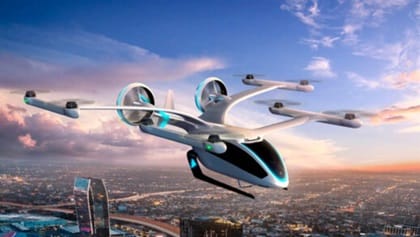Flying taxis and where to find them
Sustainability editor Flora Dickie explores the role that flying taxis may take in future sustainability efforts and whether these tech-based efforts are truly sustainable

I don’t know about you, but last week I couldn’t believe it that flying-taxis are becoming a reality. My brain completely backed up, and I was having a hard time imagining how they would integrate into our current societies.
In 2022, Santiago de Compostela, my nearest city, will become a testing and demonstration base for new flying vehicle technology, to be the future of urban mobility. Spain’s aviation authority, ENAIRE, just announced plans of two EU-funded flying taxi projects to start in 2022, and that Barcelona could be the first Spanish city to have the technology incorporated into daily life.
Spain is a popular region for the testing of eVTOLs (electric vertical take-off and landing) aircraft. Many companies, such as eHang and Tecnalia test vehicles in Spain for the large expanses of land available. ENAIRE’s director has stated that its projects in Spain will take ‘urban mobility to the 3rd dimension in an efficient and sustainable way’ therefore people will be more easily able to move between urban and suburban areas. A researcher from the Polytechnic University of Valencia has said that with the EU’s approval of flying taxi transportation, proposed for 2023, the technology will become a reality.
The primary motivation behind this innovation is to create a more sustainable mode of transportation; however, often, the only measure of sustainability used is the environmental variable of greenhouse gas emissions. For this reason, eVTOL aircraft are seen as being a climate change solution, or an eco-friendly way to travel. Additionally, it is supposed that flying vehicles will reduce congestion and travel times.
Something lacking from most technology research is a true sustainability assessment. The aim of many companies after testing their aircraft technology is to mass produce these eVTOLs. Yet, mass production of anything is not sustainable, especially when it involves a lot of raw materials. A 2019 article from Nature said that the electric engine is more efficient than a combustion engine, plus, they reduce travel times, and they produce less greenhouse gas emissions than electric ground vehicles (for trips beyond 35km). But this means that the fraction of trips in which they are more sustainable is small. Furthermore, the sustainability of these vehicles highly depends on the carbon intensity of local energy production. A full life cycle analysis from production to disposal is needed to understand their environmental impact.
Over positivity of technological solutions doesn’t target the root problems of climate change. Surely it would be more effective and sustainable to understand why we have congestion, slow travel times, and some ground-level transport systems bursting at the seams. In highly congested cities, it would be more useful to re-design neighbourhoods and de-centralise services so that citizens don’t have to travel so far for work every day. Plus, we should focus on improving the quality and efficiency of our current travel systems. The COVID19 pandemic has shown us that we travel too much and that our resilience comes from our community. So, our solutions need to be strengthening communities and providing people what they need, near to where they live.
When science and technology try to create climate change solutions, they overlook fundamental social issues (such as overconsumption, global inequality and industrial agriculture) in favour of technological strategies. Even if we reduce our carbon dioxide emissions, social inequality will still exist. Social and cultural systems keep people trapped in using unsustainable industries like coal power and chemical-intensive agriculture. In this way, our solutions must be place-based and socially focused, and technology could play its part when its foundations are rooted in a systems approach.





